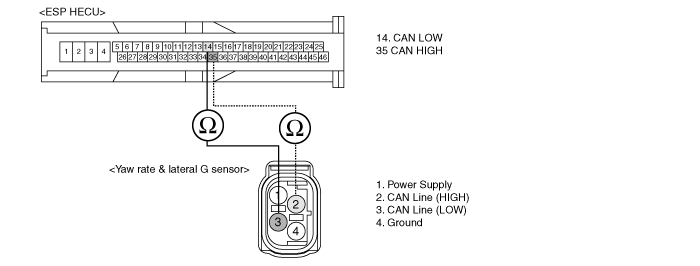Has a problem been found?

▶ Repair as necessary and then go to "Verification Of Vehicle Repair" procedure.

▶ Go to "Power Circuit Inspection" procedure.

The yaw-rate sensor and later G sensor is installed on the lower floor. The yaw-rate sensor detects acceleration of the vehicle around its vertical axis, while the G sensor detects lateral acceleration of the vehicle. It sends messages to HECU through CAN communcition line.
The HECU checks the CAN communcation lines for normal ESP control, and sets this code if an Yaw Rate & Lateral G Sensor message is not received within predefined time.
Item | Detecting Condition | Possible cause |
DTC Strategy | ● CAN massage monitoring | ● Faulty Yaw Rate & Lateral G Sensor ● Faulty HECU |
Monitoring Period | ● Continuous | |
Enable Conditions | ● Faults are detected if Yaw Rate & Lateral G Sensor message was not received on time by the CAN controller of HECU. | |
Fail Safe | ● Inhibit the ESP control and allow the ABS/EBD control. |
Many malfunctions in the electrical system are caused by poor harness(es) and terminal condition. Faults can also be caused by interference from other electrical systems, and mechanical or chemical damage.
Thoroughly check connectors for looseness, poor connection, bending, corrosion, contamination, deterioration, or damage.
Has a problem been found?

▶ Repair as necessary and then go to "Verification Of Vehicle Repair" procedure.

▶ Go to "Power Circuit Inspection" procedure.
Ignition "ON" & Engine "OFF".
Measure voltage between terminal "1" of the yaw rate & lateral G sensor harness connector and chassis ground.
Specification : Approx. B+

Is the measured voltage within specifications?

▶ Go to "Ground Circuit Inspection" procedure..

▶ Check for damaged harness and poor connection between the battery terminal(+) and terminal "1" of the yaw rate & lateral G sensor harness connector. Check for open or blown 10A fuse referring to "Circuit Diagram". Repair as necessary and then go to "Verification of vehicle Repair" procedure.
Ignition "OFF".
Disconnet the yaw rate & lateral G sensor harness connector.
Measure resistance between terminal "4" of the yaw rate & lateral G sensor harness connector and chassis ground.
Specification : Approx. 1 Ω

Is the measured resistance within specifications?

▶ Go to "Signal Circuit Inspection" procedure.

▶ Check for damaged harness and poor connection between terminal "4" of the yaw rate & lateral G sensor harness connector and chassis ground. Repair as necessary and then go to "Verification of vehicle Repair" procedure.
Ignition "OFF".
Disconnet the HECU harness connector and yaw rate & lateral G sensor harness connector .
Measure resistance between the terminal "14, 35" of the HECU harness connector and the terminal "2, 3" of the yaw rate & lateral G sensor harness connector.
Specification : Approx. 0Ω

Is the measured resistance within specifications?

▶ Go to "Component inspection" procedure.

▶ Check for open between the the terminal "14, 35" of the HECU harness connector and the terminal "2, 3" of the yaw rate & lateral G sensor harness connector. Repair as necessary and then go to "Verification of vehicle Repair" procedure.
Ignition "OFF".
Ignition "ON".
Connect scantool and select "Diagnostic Trouble Codes(DTCs)" mode
Using a scantool, Clear DTC.
Select "Diagnostic Trouble Codes(DTCs)" mode again.
Are any DTCs present ?

Substitute with a known-good Yaw Rate & Lateral G sensor and check for proper operation. If problem is corrected, replace Yaw Rate & Lateral G sensor and then go to "Verification of Vehicle Repair" procedure.
Substitute with a known-good HECU and check for proper operation. If problem is corrected, replace HECU and then go to "Verification of Vehicle Repair" procedure.

▶ Fault is intermittent caused by faulty HECU or was repaired and HECU memory was not cleared. Go to "Verification of Vehicle Repair" procedure.
After a repair, it is essential to verify that the fault has been corrected.
Connect scantool and select "Diagnostic Trouble Codes (DTCs)" mode
Using a scantool, Clear DTC.
Operate the vehicle within DTC Detecting Condition in General Information
Are any DTCs present?

▶ Go to the applicable troubleshooting procedure.

▶ System performing to specification at this time.